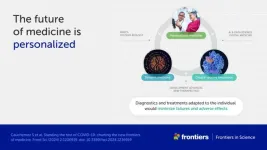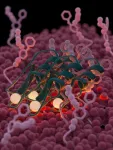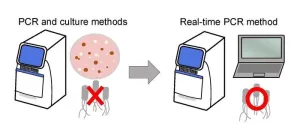(Press-News.org) As the European Space Agency publishes the first findings from its Euclid space telescope, scientists from the University of Surrey are celebrating fresh insights from the data.
Dr Denis Erkal, Associate Professor of Astrophysics at the University of Surrey, studies how the gravity of the Milky Way pulls clusters of stars apart, creating streams of stars trailing across the galaxy.
Now, his model for how this happens (video HERE) has been confirmed by data from Euclid.
Dr Erkal said:
“For a long time, my modelling predicted how the gravity of our Galaxy would pull apart clusters of stars like Messier 10.
“This first data from Euclid shows M10 behaving almost exactly as our models predicted it would. With future data from Euclid, we can explore how many of the star clusters in our Galaxy are getting pulled apart.
“Euclid has brought thousands of scientists together across hundreds of universities. By getting involved, Surrey has been able to continue our pioneering research into these streams of stars.”
Dr Erkal also worked with Dr Michelle Collins to help the Euclid team identify possible new galaxies in the telescope’s images.
Dr Collins said:
“These stunning first images are just the tip of the iceberg. Euclid’s powerful equipment can reveal small dwarf galaxies, identify free-floating rogue planets, and help us understand dark matter.
“This telescope can reveal millions of new objects in a single day. We’re only just beginning to realise its potential.”
ENDS
END
VIDEO: Surrey astrophysicists explore new galaxies and streams of stars using new data from Euclid space telescope
2024-05-23
ELSE PRESS RELEASES FROM THIS DATE:
Scientists reveal first data from Euclid telescope offering snapshot of cosmic history
2024-05-23
Scientists have released the first set of scientific data captured with the Euclid telescope, showing an exciting glimpse of the Universe’s distant past.
The telescope, launched in July 2023, is part of the Dark Energy Satellite Mission, which aims to map the dark Universe.
Led by the European Space Agency in collaboration with The Euclid Consortium - which includes astronomers at The University of Manchester in leadership positions – the mission seeks to unlock mysteries of dark matter and dark energy and reveal how and why the Universe looks as it does today.
Early observations, described in a series ...
Big data, AI, and personalized medicine: scientists reveal playbook aiming to revolutionize healthcare
2024-05-23
What should the medicine of the future look like? A team of scientists writing in Frontiers in Science lays out a bold vision for precision approaches to understanding, preventing, and treating diseases, driven by revolutionary technologies and new interdisciplinary collaborations between researchers and other health sector professionals. The internationally renowned authors – led by Prof Michel Goldman, recipient of the Blaise Pascal Medal 2024 for his exceptional contributions to immunology and healthcare innovation, and leading microbiologist Prof Philippe Sansonetti from the Institut Pasteur and Collège ...
First ever survey of A&E triage nurses highlights problems with a lack of training, low staffing, high stress and overflowing departments
2024-05-23
Peer-reviewed - survey - people
Nurses who assess patients at emergency departments would like more training and say their decisions can be negatively impacted by the high pressures of their work.
Researchers at the University of East Anglia conducted the first ever UK survey of triage nurses to discover the background, training and decision-making processes of this role in emergency departments.
Lead author Hugh Gorick, a PhD researcher at UEA’s School of Health Sciences who also works as an assistant practitioner in an NHS hospital’s Acute Medical Unit, said: “More than 24 million patients present to emergency departments ...
The global clean water crisis looms large
2024-05-23
Water scarcity will intensify with climate and socioeconomic change, disproportionately impacting populations located in the Global South. So concludes a new Utrecht University article published in Nature Climate Change on 23 May 2024, which used a state-of-the-art global water quantity and quality model to estimate clean water scarcity until the end of the century.
Humans require clean water for drinking and sanitation purposes, but also for the production of food, energy and manufactured goods. As communities and policymakers grapple with water scarcity issues on the ground, researchers ...
Antibiotic ‘Velcro’ gives bacteria a sticky situation
2024-05-23
A small antibiotic called plectasin uses an innovative mechanism to kill bacteria. By assembling into large structures, plectasin latches onto its target on the bacterial cell surface comparable to how both sides of Velcro form a bond. A research team, led by structural biologist Markus Weingarth and biochemist Eefjan Breukink at Utrecht University, mapped how the Velcro-structure is formed. Their discovery, published in the scientific journal Nature Microbiology, unveils a new approach that could have broad implications for the development of antibiotics to ...
City of Hope researchers to present investigational treatments for colorectal, kidney and blood cancers at 2024 American Society of Clinical Oncology (ASCO) Annual Meeting
2024-05-23
LOS ANGELES — World-renowned physicians and researchers from City of Hope®, one of the largest cancer research and treatment organizations in the United States, will present new data and offer expert perspectives on leading-edge cancer research and treatments in development at the 2024 ASCO Annual Meeting, which will take place in Chicago from May 31 to June 4. Highlights include the following:
2024 Best of ASCO® program: New data on mismatched unrelated donor peripheral blood stem cell transplantation
Late-breaking data on the phase 3 CodeBreaK 300 trial
Glofitamab monotherapy for patients ...
Bigger is better: male proboscis monkeys’ enhanced noses evolved to attract mates
2024-05-23
When it comes to the animal kingdom, bigger is better. Well, at least for proboscis monkeys, famously known for their long, large and droopy noses.
Researchers from The Australian National University (ANU) have provided a world-first explanation for why male proboscis monkeys have larger and “enhanced” nasal structures.
The researchers examined the bony nasal cavity inside the skulls of proboscis monkeys and found their large noses are more than just an eye sore and in fact offer several major benefits, especially when ...
Early access to first-seizure clinics, subsequent outcomes, and factors associated with attendance
2024-05-23
About The Study: The results of this cohort study suggest that first-seizure clinic (FSC) attendance, particularly early attendance, was associated with reduced rates of subsequent hospital utilization. This knowledge may support adequately resourcing FSCs to improve equitable, timely access. Future study directions include assessing interventions that may support FSC attendance for at-risk groups.
Corresponding Author: To contact the corresponding author, Emma Foster, M.B.B.S.(Hons), Ph.D., email emma.foster@monash.edu.
To access the embargoed study: Visit our For The Media website at this link https://media.jamanetwork.com/
(doi:10.1001/jamaneurol.2024.1187)
Editor’s ...
How stores use TikTok to sell e-cigarettes to children
2024-05-23
A new paper in Nicotine and Tobacco Research, published by Oxford University Press, shows that advertising and sales of vaping products is common on TikTok, the video sharing platform popular among teenagers. Users pushing these items often use hashtags like #puffbundles to disguise vaping products by including things like lip gloss and candy in the packages for sale.
Despite smoking rates reaching an all-time low in the United States, public health professionals are concerned about adolescent use of electronic cigarettes. In 2023 some 4.7 million (17%) middle school and high school students ...
Mistaken identity cleared up of foodborne pathogen causing severe symptoms in children
2024-05-23
The prevalence of pathogenic E. coli has meant the frequent misidentification of a similar bacterium of the Escherichia genus. E. albertii is an emerging zoonotic foodborne pathogen, first isolated in Bangladesh in 1991. Large-scale outbreaks of food poisoning caused by E. albertii have since been reported especially in Japan, causing severe symptoms in both children and adults.
In the hopes of establishing a diagnostic method, a joint research group led by Professor Shinji Yamasaki and Dr. Sharda Prasad Awasthi, a specially appointed ...



